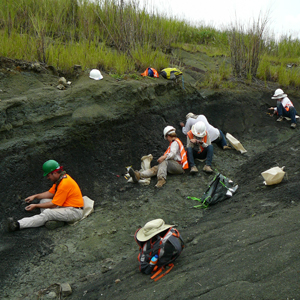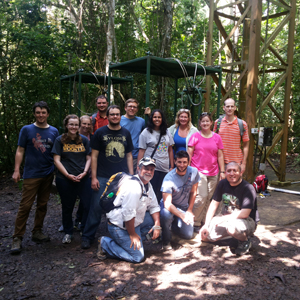By Nathan Jud | PCP PIRE Post Doc
The PCP-PIRE team traveled to Panama earlier this fall from October 5th-12th, and this time the focus was on inventory and collecting new fossils for invertebrate paleontology and paleobotany. Our team from Florida included Cristina Robins, Roger Portell, Alex Kittle, Adiël Klompmaker, Aly Tucker, Nathan Jud, Chris Nelson, Carolyn Thornton, and Jeremy Dunham; we were joined by Jon Hendricks of San Jose State University. The trip was also an opportunity for our current museum interns (Aly, Carolyn, and Jeremy) to meet and work with the “boots on the ground” interns Dipa Desai and Paris Morgan, who are working in Panama with Jorge Moreno-Bernal.

We began the week on Tuesday by splitting into two groups. Three of us went to the storage facility to organize fossils from previous trips so that they could be transported back to Florida. The remainder of the group went to the Canal to collect fossils at the relatively new Empire site. Sites like these are nice because the layers are exposed and there is no vegetation obstructing our efforts. We found a variety of mollusks and decapods, marking a successful first day.
On Wednesday we traveled as one large group to Lago Alajuela in Chagres National Park. Fossil vertebrates including gomphotheres, turtles, and crocodilians can be found on the shore when the lake levels are low, but the uppermost beds contain the fossil invertebrates and fossil woods that we were interested in collecting. Nonetheless, the high water did present some challenges and part of the group spent some time bushwhacking through the vegetation to relocate a site where a previous group had collected a well-preserve echinoid. Meanwhile, Jeremy, Carolyn, Chris and I collected fossil woods and associated sediment for geochemical analysis and we caught up with the rest of the group after they finished blazing a trail through the elephant grass and thorny legumes. We had a successful afternoon collecting invertebrates, and we also discovered fossilized leaves preserved in what we have interpreted as an algal mat.

Thursday we once again divided into two groups. I lead one group back to the Canal to collect plant fossils, while Roger and Cristina led the other group to Lago Gatún to collect invertebrates. My group spent the morning collecting fossil wood and leaves at the Empire site, and the afternoon prospecting and removing overburden for a quarry in an area that I thought was promising for fossil leaves based on a previous trip. The other group started their day at the San Judas locality where they collected hundreds of fossils, including 564 cone snails now on loan to Jon Hendricks. Then, they stopped by the Texaco site where various marine invertebrates and vertebrates were collected in the past, but found the site inaccessible. Next they visited a site known as Sand Dollar Hill, and although vegetation was taking over the site, they managed to collect a very nice specimen of Aturia, an extinct genus of Miocene nautilids. Finally, they ended the day back at the San Judas site for a bit more collecting.
On Friday, the paleobotany group returned to the Canal to collect fossil leaves in the new quarry, but our efforts were met with modest success. We collected some leaves but the rocks were so deeply weathered we were not able to get large blocks. Instead we collected several samples to process for dispersed cuticle and pollen. Meanwhile, the invertebrate group returned to the Empire site for more decapods, mollusks, and bivalves.
Overall, we had a very successful week, and we ended our trip with a tour of some of Panama City’s attractions. Early in the morning we rode in the canopy crane at the Metro Park outside of the city and had a close encounter with a mother sloth and her baby. Later in the day we visited the Smithsonian’s frog exhibit at Punta Culebra and spent some time at the Biomuseo. Finally, we headed to Casco Viejo for ice cream and spent the evening exploring the city.
Por Nathan Jud | PCP-PIRE Post-Doctorado
Traducido por Lucy Taylor
El equipo de PCP-PIRE viajó a Panamá el 5º-12º de Octubre, y esta vez los focos fueron clasificar el inventario y recoger nuevos fósiles de los invertebrados y de las plantas. Nuestro equipo de Florida incluyó a Cristina Robins, Roger Portell, Alex Kittle, Adiël Klompmaker, Aly Tucker, Nathan Jud, Chris Nelson, Carolyn Thornton, y Jeremy Dunham; también nos reunió Jon Hendricks, de San Jose State University en California. El viaje fue una buena oportunidad para nuestros estudiantes del museo (Aly, Carolyn, y Jeremy) para conocer a, y trabajar con, las becarias en el campo Dipa Desai y Paris Morgan, quienes están trabajando en Panamá con Jorge Moreno Bernal.

Empezamos la semana el martes, y nos separamos en dos grupos. Tres miembros del equipo fueron al almacén para categorizar y ordenar los fósiles recogidos durante viajes pasados, para que pudieran estar listos a transportarse a Florida. El resto del equipo fue al canal de Panamá para recoger fósiles al nuevo sitio de Empire. Estos sitios, como el de Empire, son buenos porque los afloramientos están expuestos, y no hay vegetación bloqueando nuestros esfuerzos. Encontramos una variedad de moluscos y decápodos, que nos significó que el primer día fue un éxito.
El miércoles, viajamos como grupo singular al lago Alajuela, una parte del Parque Nacional Chagres. Cuándo el nivel del lago está bajo, se pueden encontrar fósiles de vertebrados, incluyendo gonfotéridos, tortugas, y cocodrilos. Los fósiles de invertebrados y maderas que queríamos recoger estaban en los afloramientos superiores de la orilla. Sin embargo, el nivel alto de agua nos presentó unos retos, y una parte del equipo tuvo que machetear la maleza para reencontrar un sitio cubierto, donde un grupo previo había recogido un equinodermo muy bien preservado. Mientras tanto, Jeremy, Carolyn, Chris, y yo (Nathan) recogimos maderas fosilizadas y el sedimento asociado con ellas, para hacer una análisis geoquímica. Nos reunimos con el resto del grupo después de que terminaron de cortar los carrizos altos y los legumbres espinosos. Pasamos la tarde con éxito, recogiendo invertebrados, y también descubrimos hojas fosilizadas, que fueron preservadas en algo que interpretamos como una mata de algas.

El jueves, otra vez nos dividimos en dos grupos. Yo (Nathan) dirigía a un grupo, y regresamos al canal para recoger fósiles de plantas, mientras que Roger y Cristina dirigían al otro, que viajó al lago Gatún a buscar invertebrados. El grupo mío pasaba la mañana buscando hojas y maderas fosilizadas, y por la tarde hicimos una prospección y removimos los sedimentos encima de una nueva cantera, en que pensé que hubieran fósiles de hojas a partir de un viaje pasado. El otro grupo empezó su día en un sitio de Gatún conocido como San Judas, dónde recogieron cientos de fósiles, incluyendo 564 caracoles cónicos, que hoy en día los estamos prestando a Jon Hendricks. Después, visitaron el sitio de Texaco, donde varios especímenes de fósiles marinos vertebrados e invertebrados habían sido encontrado en el pasado, pero supieron que el sitio no estaba accesible. Entonces fueron a un sitio llamado “la colina de dólares de arena”, y a pesar de la vegetación densa, alcanzaron a recoger un buen espécimen de Aturia, un género extinto de nautílidos del Mioceno. Finalmente, regresaron al sitio San Judas a recoger un poquito más.
El viernes, el grupo de paleobotánica volvió al canal a buscar fósiles de hojas en la nueva cantera, pero no teníamos mucho éxito. Encontramos unas hojas, pero las piedras estaban tan erosionadas que no podíamos extraer bloques grandes. En vez de eso, sacamos unas muestras para buscar polen y cutículas dispersadas. El otro grupo regresó al sitio Empire para recoger más decápodos, moluscos, y bivalvos.
En general, teníamos mucho éxito durante la semana, y terminamos nuestro viaje con un tour de unos de las atracciones de la Ciudad de Panamá. Por la mañana temprana, fuimos a la grúa del Parque Metropolitano, donde tuvimos un encuentro de sorpresa con un perezoso y su bebé. Luego visitamos a la exhibición de ranas del Smithsonian en Punta Culebra, y pasamos un rato en el Biomuseo. Finalmente, por la tarde fuimos a Casco Viejo para comprar un helado, y exploramos la ciudad.